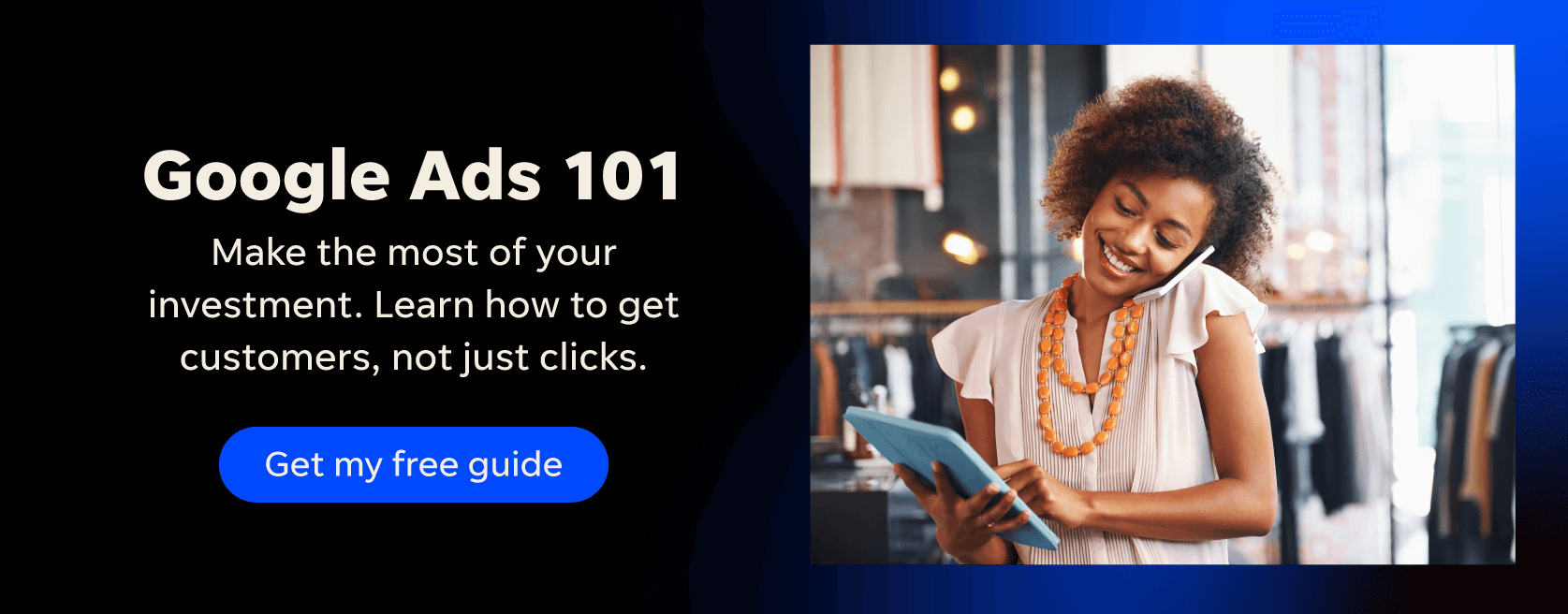Search engine optimization (SEO) alone throws many people for a loop. With 200+ ranking factors, white, black, and grey hat tactics, Google core updates, and a bunch of other details to worry about, SEO can seem complex. And it certainly doesn’t help that search engine marketing (SEM)—a related but not identical term—is often mistaken for SEO, adding to the confusion.

However, as the internet becomes more crowded, understanding how you can work with search engines to bring ideal customers to you has become more important than ever. And that starts with developing a clear understanding of SEO, SEM, and PPC, as well as their differences and similarities. So in this guide, we’re going to walk you through:
- What SEO and SEM really are
- The key differences between SEO and SEM (and PPC)
- The similarities between SEO and SEM (and PPC)
- How to choose SEO/SEM for your marketing strategy
Let’s start defining!
What’s the difference between SEO, SEM, and PPC?
Let’s start with an overview of the definitions of each term to understand how they differ.
SEO: What it is and what it involves
Search engine optimization is the process of continually optimizing a website to rank or show up in organic search results. Or, in other words, optimizing for results that rank naturally instead of through paid ads such as Google Ads.
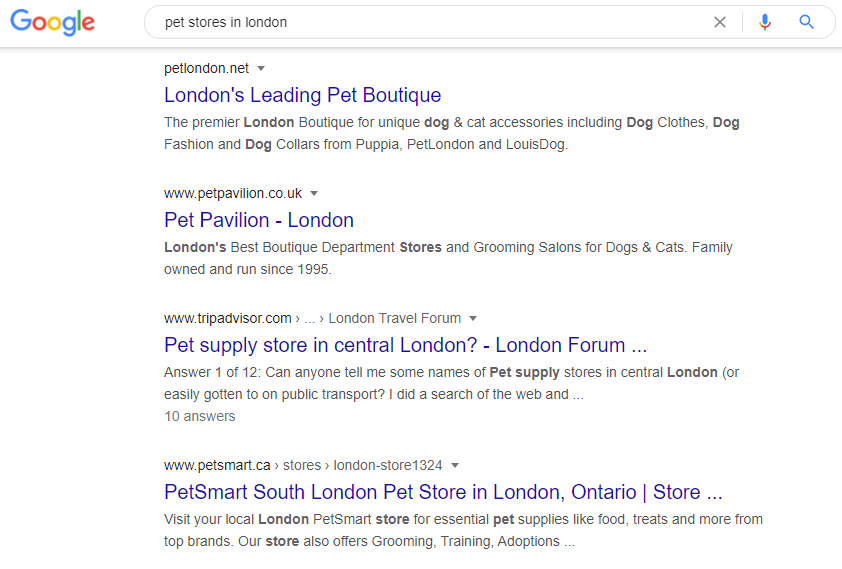
But, to be clear, the goal of SEO isn’t just to show up somewhere in relevant results. It’s to rank:
- In search results that are relevant to what your business does and, on a more granular level, relevant to where each website visitor is in the journey to becoming a customer of yours.
- As high up as possible on the first page of relevant search engine results pages (SERPs) since the top three Google search results get 75.1% of all clicks and very few people ever visit page two of search results (sad, but true).

To achieve both and drive traffic to your website that you can convert into leads, there are several sub-practices of SEO that work hand-in-hand with one another. They include:
- Content creation and, specifically, delivering high-quality content that meets your target audience’s needs in the right way and at the right time.
- On-page optimization, which involves targeting the keywords you want to rank for in your title and image alt tags, meta descriptions, page URLs, and other key places.
- Off-page optimization, which involves link building (AKA getting backlinks from trusted websites that pass authority to your site), citation building, and managing online profiles like Google Business Profile.
- Technical SEO, which involves optimizing for mobile devices, as well as improving site speed, crawlability, and indexing to help search engines navigate and understand your site.
Want to know how your website SEO is performing? Try our free website grader to get your score!
One benefit of SEO is that it can drive traffic for “free” unlike other strategies that involve direct payment. However, keep in mind that it does still require a significant investment of time and resources and can even cost some money if, for example, you decide to outsource a portion of the work.
What about SEOs misunderstood relatives, PPC and SEM?
PPC: What it is and how it’s beneficial
Pay-per-click advertising—PPC for short—involves buying the ad slots that appear in search results.
Most commonly, you’ve seen these search ads at the top of search results pages on Google and other search engines. They’re often valuable because they appear before organic search results. So, if the web pages taking up that real estate offer just what searchers are looking for, they may be clicked first.

For example, LOCALiQ’s 2021 search advertising data revealed an average click-through rate of 6.18% for Google and Bing Ads, as well as an average conversion rate of 8.82% across 23 industries.
So, for instance, if your ad is shown to 1,000 people, a:
- 6.18% click-through rate (CTR) would mean that 62 people clicked on it.
- 8.82% conversion rate (CR) would mean that five or six people out of the 62 who clicked took a desired action such as buying your product.
True, five or six conversions out of 1,000 might not sound like a jaw-dropping success. But, when you need customers now, it can be a major win. This is especially true when you have a repeatable way to get five or six or more through ads anytime you need them.
To illustrate, the alternative—relying solely on organic content marketing—might require an investment of countless hours and resources to attract your target audience. And that may be followed by several months of nurturing the people you’ve attracted until they’re ready to buy. Not ideal if you need a more immediate result.
So, in a nutshell, paid tactics can be incredibly powerful if you:
- Have a sizeable and consistent budget for PPC ads, especially if you’re in an industry where competitors pay big bucks for promising front and center SERP placements.
- Can achieve a reasonable cost per click (CPC) for keywords that are likely to turn leads into customers quickly.
- Target the right search terms, target the people most likely to buy based on demographic and psychographic info, and write compelling copy that motivates them to click and convert.
With all of the above working in your favor, you can rack up prospects and sales faster than with an SEO strategy.
SEM: What it really is
Lastly, there’s SEM, which is the most misunderstood term out of the three. Some marketers use it to refer only to PPC. And others use it to refer to PPC alone and the combination of paid and organic methods.
But SEO is technically a form of search engine marketing. So neither of the above uses of terminology are the most sensible or clear. To avoid confusion, these are the definitions we’ll use:
- SEO to refer to organic efforts
- Paid search to refer to pay-per-click (PPC) ads
- SEM to refer to both types of strategies
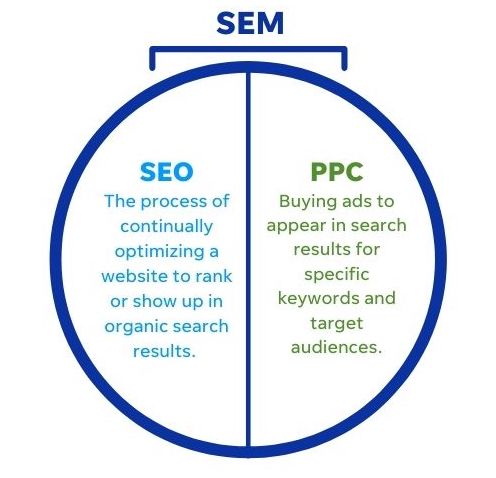
With that in mind, let’s dig a little deeper into each strategy.
What are the similarities between PPC, SEO, and SEM?
Up to this point, we’ve talked a bit about the main differences between organic and paid strategies. But what do PPC (or, as some call it, “SEM”) and SEO have in common? Both are:
- Designed to increase the discoverability of your website through search engines and, as a result, bring you more and higher quality traffic.
- Keyword-based and require keyword research to identify search queries your target audience uses to find the information and content you’re sharing on your site.
- Ongoing processes that need to be continuously monitored and optimized to deliver the best return on investment (ROI).
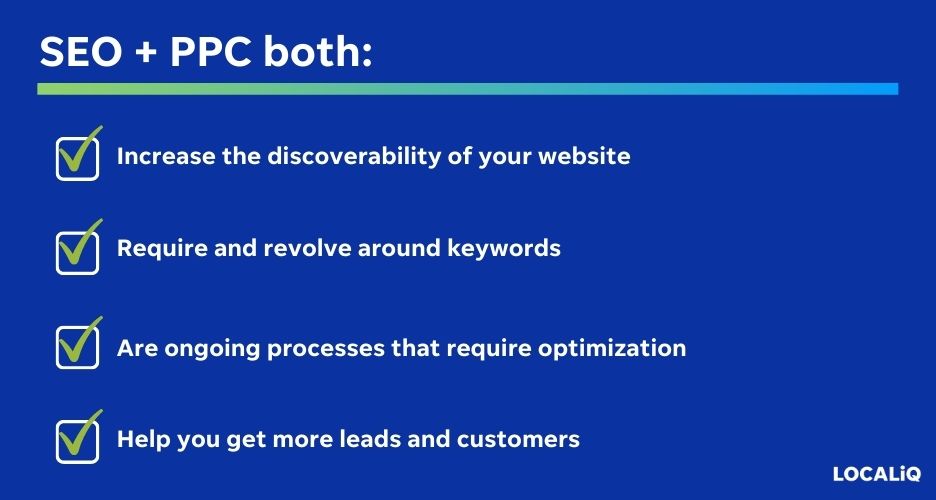
Given these similarities, it’s no wonder that organic SEO strategy and ads can be used together to win coveted search rankings and drive traffic. And we’ll talk about how to do that shortly. But, first, let’s consider how to decide between the two if you must.
SEO vs. SEM vs. PPC: How to decide which is better for your strategy
There are, of course, advantages and disadvantages to all three. So here are several criteria to help you decide what to start with or even if you should invest in both.
1. Your budget
Especially if you’re in a competitive industry full of giant companies with giant budgets, paying to advertise on search engines can be expensive. So, if your budget isn’t what you’d like it to be right now, SEO is a better and more sustainable route. This is where understanding the average cost per click can help.
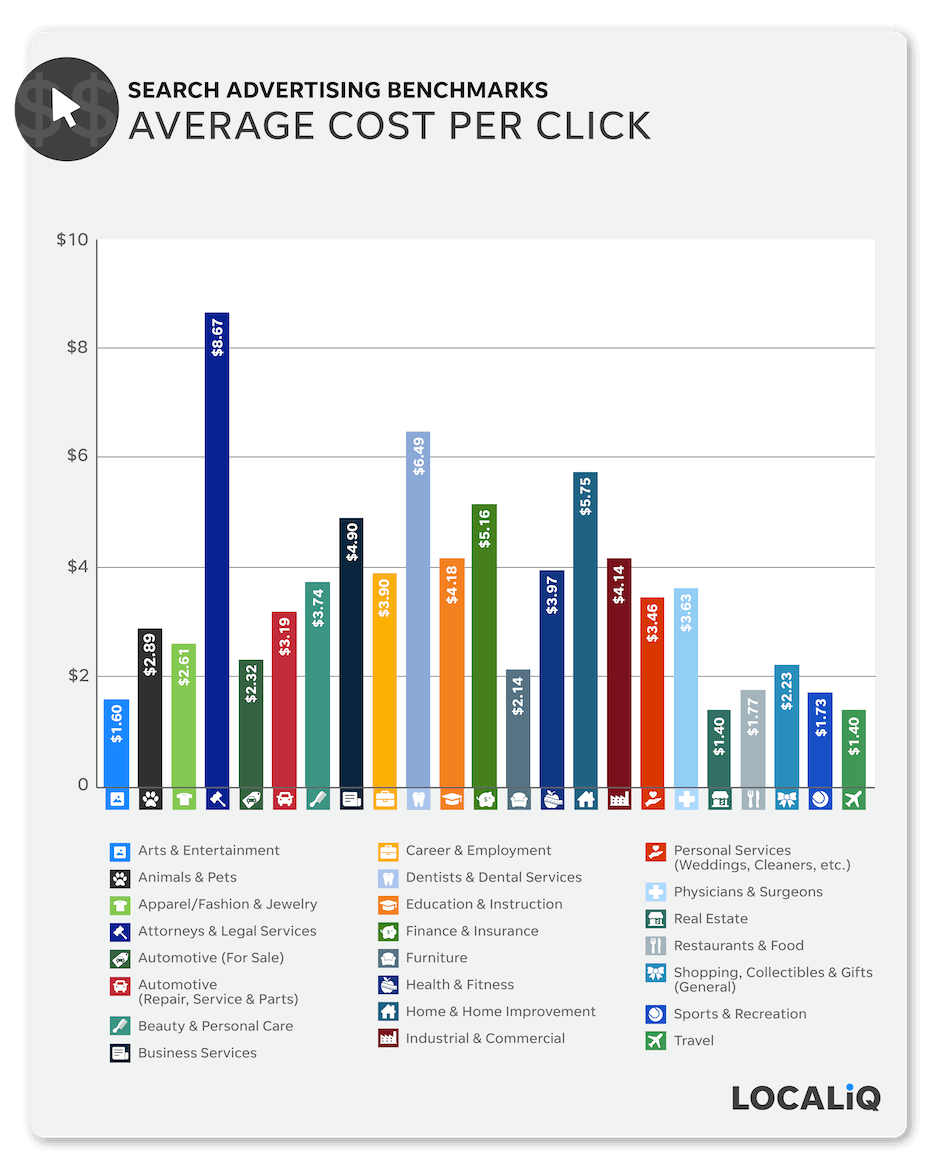
Related: Get search advertising benchmarks to find out what you can expect from paid ads.
2. The probable ROI
Speaking of the cost of paid ad campaigns, consider your profit margins and customer lifetime value.
Let’s say you’re selling an inexpensive or one-time use product, for example. The CPC may not be worth it based on your conversion rates. If that’s the case, SEO would be a safer, more cost-effective strategy to invest in.
3. Your goals
If you want to build topical authority and become known as a go-to source of trustworthy information in your industry, SEO is a good option. It generally involves creating content on informational keywords, which gives you a chance to show your expertise and build your reputation as a credible industry authority.
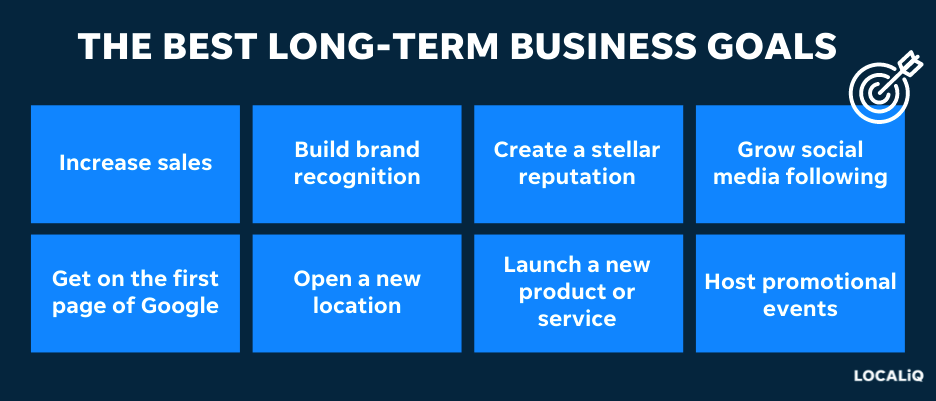
On the other hand, what if your main focus is generating new business? PPC is the way to go since you’d mostly be bidding on high-intent keywords, which signals that searchers are likely to make a purchase soon.
Similarly, if you haven’t quite nailed down your audience or offer yet and are still testing to see what sticks, ads can help you gather valuable data quickly. Whereas, you have a good foundation for SEO strategy if you know your audience well, have an attractive offer, have a good understanding of your typical sales cycle and how long it takes, etc.
Related: The 8 Best Long-Term Business Goals for Guaranteed Success (with Examples & Resources)
4. Your immediate needs
Need customers or clients in a hurry? SEM is your best bet in that case since, as mentioned, it’s typically used to target high-intent keywords. It can produce quick wins but the downside is the most tangible advantages only last as long as your ad campaigns. Stop running ads and traffic to your landing pages or sales pages will likely die down, as will conversions.
In contrast, as with content marketing in general, SEO is a long game. Any legit SEO pro will tell you upfront that it can take anywhere from three to six to 12 months to start gaining significant traction. However, once you do, SEO can produce traffic, leads, and sales 24/7/365.
In most cases, the question isn’t really whether or not you should be doing SEO; the answer is most often “yes.” The real thing to think about is whether you can afford to wait for SEO to kick in without also running ads to tide you over in the meantime.
5. Your skillset (or willingness to outsource)
In some cases, it’s possible to rank organically without manually building backlinks to your website. However, if you’ll be going after competitive keywords and trying to overtake strong websites in search results, you’ll need links. So either you’ll have to commit to building them yourself or bring on board someone with verifiable experience executing link-building strategies in addition to the other technical aspects of SEO needed for success.
And, as for ads, you have to be willing to either outsource or master the learning curve that comes with managing an ad account and PPC campaigns. That includes using advanced targeting features both to control ad spend and reach only the people most likely to respond positively to your ad. Not to mention writing ad copy, measuring return on ad spend, A/B testing landing pages, and more.

Understanding Google Ads account structure is just one part of running PPC ads yourself.
6. Available opportunities
We’ve talked a little about the competitiveness of paid advertising as it relates to things like cost per click. But it’s equally important to consider the competitiveness of the organic landscape.
Performing keyword research and, more importantly, developing a keyword strategy, will reveal opportunity gaps to help you start ranking and rising in search results. The bonus? If you stick to your plan for SEO, eventually you’ll be able to rank for more competitive and higher traffic search terms.
What are the benefits of an SEM strategy?
Clearly, there are circumstances in which you’ll need to choose between organic and paid methods of gaining visibility in search engines. But there are pros to having an SEM strategy as part of your larger digital marketing plan.
Justin Borge, Founder and CEO of Help With Your Hustle Digital Marketing Agency summed it up this way:
“Although lucrative and predictable, SEO takes time to pay off. The problem is that many businesses need money in the short term and can’t afford to wait for it to kick in. That’s where ads come in, creating a cycle that not only promotes sales and buys operating time but drives traffic to your site for Google to use the signals from to begin ranking you for SEO sooner. The sooner your SEO kicks in, the sooner you make money, which you can then funnel a portion of back into ads. Used in tandem, they’re the ultimate power couple.”
As Justin said, SEM is a double-whammy. The immediate impact of showing up in paid search results can make up for the time SEO takes. And the long-term visibility and traffic SEO generates can make up for the cost and short-term nature of PPC campaigns.
As a result, your brand and website can take up more real estate on SERPs, especially if you can rank via organic strategies and land an ad placement for the same lucrative keyword.
Related: Find out more ways SEO plus PPC work together.
Will you do PPC, SEO, or SEM?
We’ve covered the two strategies that make up SEM, how they differ, the characteristics they share, and when to use one or both. Now, all that’s left is for you to decide which one you’ll invest in first or to seek some expert guidance on the appropriate strategy for your business. No matter which one you choose, the sooner you start, the sooner you can start optimizing for the best results!
Related Articles
-

How to Replicate Your Google Ads on Bing for More Clicks at Lower Costs
-

How Much Should You Spend in Google Ads? Complete Guide to PPC Costs
-

Google Local Services Ads 101: Everything You Need to Know
-

Updated Search Advertising Benchmarks for 2024 (+Expert Tips to Improve Results)
-

Essential Beginner's Guide to Local PPC

